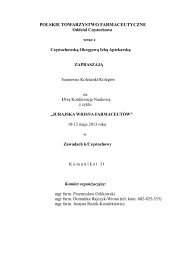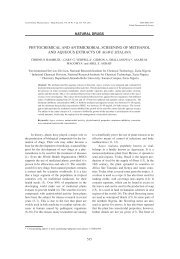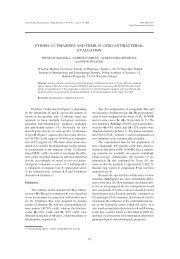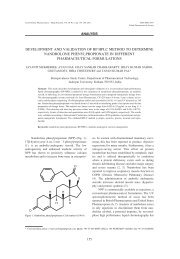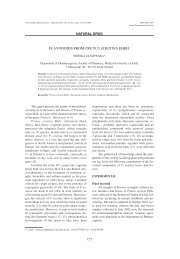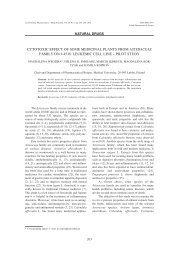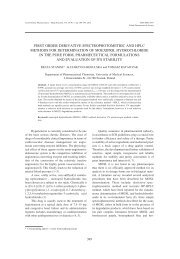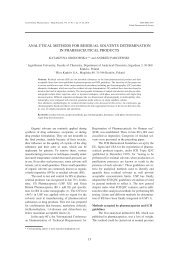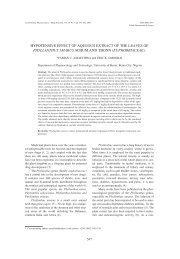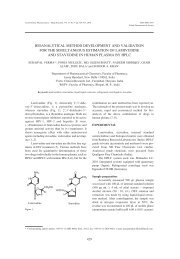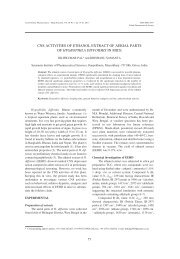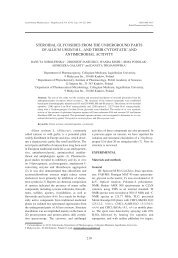Phytochemical and acute toxicity study on Bryophyllum calycinum
Phytochemical and acute toxicity study on Bryophyllum calycinum
Phytochemical and acute toxicity study on Bryophyllum calycinum
Create successful ePaper yourself
Turn your PDF publications into a flip-book with our unique Google optimized e-Paper software.
Acta Pol<strong>on</strong>iae Pharmaceutica ñ Drug Research, Vol. 65 No. 4 pp. 501ñ504, 2008 ISSN 0001-6837<br />
Polish Pharmaceutical Society<br />
SHORT COMMUNICATION<br />
PHYTOCHEMICAL AND ACUTE TOXICITY STUDY<br />
ON BRYOPHYLLUM CALYCINUM SALISB.<br />
DEBABRATA DEVBHUTI * , JAYANTA KUMAR GUPTA, PRITESH DEVBHUTI<br />
<str<strong>on</strong>g>and</str<strong>on</strong>g> ANINDYA BOSE<br />
Divisi<strong>on</strong> of Medicinal <str<strong>on</strong>g>and</str<strong>on</strong>g> Pharmaceutical Chemistry, Department of Pharmaceutical Technology,<br />
Jadavpur University, Kolkata-700032, India<br />
Keywords: <strong>Bryophyllum</strong> <strong>calycinum</strong> Salisb. (Crassulaceae), phytochemical investigati<strong>on</strong>, <str<strong>on</strong>g>acute</str<strong>on</strong>g> <str<strong>on</strong>g>toxicity</str<strong>on</strong>g> <str<strong>on</strong>g>study</str<strong>on</strong>g>.<br />
The plant <strong>Bryophyllum</strong> <strong>calycinum</strong> Salisb.<br />
(Crassulaceae ) is a shrub mainly found in the tropical<br />
parts of Bengal <str<strong>on</strong>g>and</str<strong>on</strong>g> in southern Africa <str<strong>on</strong>g>and</str<strong>on</strong>g><br />
American c<strong>on</strong>tinents. It is locally known as<br />
ìPatharkuchiì <str<strong>on</strong>g>and</str<strong>on</strong>g> for l<strong>on</strong>g has been used in<br />
Ayurvedic medicine. As per traditi<strong>on</strong>al use, the<br />
leaves <str<strong>on</strong>g>and</str<strong>on</strong>g> leaf juice are used as antiviral, antipyretic,<br />
antimicrobial, anti-inflammatory, antitumorous,<br />
hypocholesterolemic, antioxidant, diuretic, antiulcer,<br />
styptic, antidiabetic, astringent, antiseptic,<br />
antilithic <str<strong>on</strong>g>and</str<strong>on</strong>g> cough suppressant (1-9). Some activities<br />
of some plants of this genus have been reported<br />
(10-12). The present <str<strong>on</strong>g>study</str<strong>on</strong>g> was undertaken to report<br />
the phytoc<strong>on</strong>stituents present in successive extracts<br />
of the leaves of the plant, to determine the ash values<br />
<str<strong>on</strong>g>and</str<strong>on</strong>g> extractive values of the dried leaves <str<strong>on</strong>g>and</str<strong>on</strong>g> to<br />
find out the LD 50 values of methanolic <str<strong>on</strong>g>and</str<strong>on</strong>g> aqueous<br />
extracts of the leaves of the plant.<br />
EXPERIMENTAL<br />
Plant material<br />
The plant was identified (Ref. No. CNH/I-<br />
I(53)/2004-Tech-I/885) by the tax<strong>on</strong>omists of<br />
Botanical Survey of India, Shibpur, Howrah. After<br />
authenticati<strong>on</strong>, the fresh leaves were collected in<br />
bulk from young matured plants at the rural areas of<br />
Howrah during August ñ September 2005 <str<strong>on</strong>g>and</str<strong>on</strong>g><br />
washed, shade dried <str<strong>on</strong>g>and</str<strong>on</strong>g> milled into coarse powder<br />
by a mechanical grinder. The powder was passed<br />
through sieve number 40 (B.P. st<str<strong>on</strong>g>and</str<strong>on</strong>g>ard) <str<strong>on</strong>g>and</str<strong>on</strong>g> used<br />
for further studies.<br />
Preparati<strong>on</strong> of extracts<br />
The powdered plant material was extracted<br />
successively with analytical grade, redistilled petroleum<br />
ether (40-60 O C), chloroform <str<strong>on</strong>g>and</str<strong>on</strong>g> methanol<br />
(procured from S.B. Fine Chem. Ltd., Mumbai <str<strong>on</strong>g>and</str<strong>on</strong>g><br />
Merck, Mumbai, respectively) using Soxhlet apparatus.<br />
The solvents were removed under reduced<br />
pressure to obtain greenish-black (PE), brownishblack<br />
(CE) <str<strong>on</strong>g>and</str<strong>on</strong>g> blackish-brown (ME) colored solid<br />
residues (yield 3%, 1.8% <str<strong>on</strong>g>and</str<strong>on</strong>g> 5.7% w/w <strong>on</strong> dried<br />
plant material basis, respectively). The aqueous<br />
extract was prepared by decocti<strong>on</strong> process using<br />
double distilled water <str<strong>on</strong>g>and</str<strong>on</strong>g> then it was filtered, evaporated<br />
<str<strong>on</strong>g>and</str<strong>on</strong>g> dried under reduced pressure to yield<br />
solid residue (AE) with a yield of 21% w/w <strong>on</strong> dried<br />
plant material basis. <str<strong>on</strong>g>Phytochemical</str<strong>on</strong>g> investigati<strong>on</strong>s<br />
were performed <strong>on</strong> all the four extracts <str<strong>on</strong>g>and</str<strong>on</strong>g> LD 50<br />
<str<strong>on</strong>g>study</str<strong>on</strong>g> was d<strong>on</strong>e <strong>on</strong> methanolic <str<strong>on</strong>g>and</str<strong>on</strong>g> aqueous extracts<br />
<strong>on</strong>ly in mice <str<strong>on</strong>g>and</str<strong>on</strong>g> rats.<br />
Preliminary phytochemical analysis<br />
The extracts prepared in different solvents<br />
were taken <str<strong>on</strong>g>and</str<strong>on</strong>g> st<str<strong>on</strong>g>and</str<strong>on</strong>g>ard methods were used to<br />
detect the nature of phytoc<strong>on</strong>stituents present in<br />
them (13-16).<br />
Determinati<strong>on</strong> of total ash<br />
About 2-3 g accurately weighed powdered<br />
drug was incinerated in a silica dish at a temperature<br />
not exceeding 450 O C until free from carb<strong>on</strong>. It was<br />
then cooled <str<strong>on</strong>g>and</str<strong>on</strong>g> weighed. The % w/w of ash with<br />
reference to the air-dried drug was calculated (17).<br />
Determinati<strong>on</strong> of alcohol soluble extractive<br />
Accurately weighed 5 g of air-dried powdered<br />
drug was macerated with 100 mL of alcohol of the<br />
specified strength in a closed flask for 24 h, shaken<br />
frequently during first 6 h <str<strong>on</strong>g>and</str<strong>on</strong>g> allowed to st<str<strong>on</strong>g>and</str<strong>on</strong>g> for<br />
18 h. It was then filtered rapidly, taking precauti<strong>on</strong>s<br />
* Corresp<strong>on</strong>ding author: e-mail: ddjupt@yahoo.co.in<br />
501
502 DEBABRATA DEVBHUTI et al.<br />
against loss of the solvent <str<strong>on</strong>g>and</str<strong>on</strong>g> 25 mL of the filtrate<br />
were evaporated to dryness in a tared flat-bottomed<br />
shallow dish <str<strong>on</strong>g>and</str<strong>on</strong>g> dried at 100 o C to c<strong>on</strong>stant weight.<br />
The % w/w of alcohol soluble extractive value was<br />
calculated with reference to the air-dried drug (17).<br />
Determinati<strong>on</strong> of water soluble extractive<br />
Procedure was the same as for alcohol soluble<br />
extractive using water instead of ethanol.<br />
Determinati<strong>on</strong> of sodium, potassium <str<strong>on</strong>g>and</str<strong>on</strong>g> calcium<br />
An accurately weighed amount of the ash of<br />
the plant was digested with 5 mL of 10% HCl <str<strong>on</strong>g>and</str<strong>on</strong>g><br />
filtered through Whatmann No. 41 filter paper. The<br />
residue was washed with hot water, cooled <str<strong>on</strong>g>and</str<strong>on</strong>g><br />
made to volume. The sample soluti<strong>on</strong> was then compared<br />
in the flame photometer against st<str<strong>on</strong>g>and</str<strong>on</strong>g>ard soluti<strong>on</strong>s<br />
of NaCl, KCl <str<strong>on</strong>g>and</str<strong>on</strong>g> CaCO 3 c<strong>on</strong>taining the same<br />
amount of HCl. The c<strong>on</strong>centrati<strong>on</strong>s of the sodium,<br />
potassium <str<strong>on</strong>g>and</str<strong>on</strong>g> calcium i<strong>on</strong>s were calculated by<br />
extrapolati<strong>on</strong> method (18).<br />
Ethical clearance<br />
The protocol used in this <str<strong>on</strong>g>study</str<strong>on</strong>g> for the use of<br />
animals was approved by the University Animal<br />
Ethical Committee.<br />
Acute <str<strong>on</strong>g>toxicity</str<strong>on</strong>g> <str<strong>on</strong>g>study</str<strong>on</strong>g><br />
Swiss albino male mice (weighing 20-25 g)<br />
<str<strong>on</strong>g>and</str<strong>on</strong>g> rats (weighing 110-130 g) were administered<br />
intraperit<strong>on</strong>eally with graded doses (350-2600<br />
mg/kg of body weight) of methanolic <str<strong>on</strong>g>and</str<strong>on</strong>g> aqueous<br />
extracts of the plant. After administrati<strong>on</strong> of the<br />
extracts the animals were observed for toxic effects<br />
during 24 h after the treatment. The toxicological<br />
effects were observed in terms of mortality <str<strong>on</strong>g>and</str<strong>on</strong>g><br />
expressed as LD 50 . The number of animals dying<br />
during the period was noted. The LD 50 of the<br />
extracts were calculated by the method of Miller <str<strong>on</strong>g>and</str<strong>on</strong>g><br />
Tainter (19, 20).<br />
The methanolic <str<strong>on</strong>g>and</str<strong>on</strong>g> aqueous extracts were also<br />
administered orally in graded doses (500-3000<br />
mg/kg body weight) in mice <str<strong>on</strong>g>and</str<strong>on</strong>g> rats to test their<br />
oral <str<strong>on</strong>g>toxicity</str<strong>on</strong>g>.<br />
RESULTS AND DISCUSSION<br />
The findings of the preliminary phytochemical<br />
investigati<strong>on</strong>s <str<strong>on</strong>g>and</str<strong>on</strong>g> the results of the LD 50 <str<strong>on</strong>g>study</str<strong>on</strong>g> were<br />
depicted in the respective Tables. The preliminary<br />
phytochemical tests performed were of qualitative<br />
type <str<strong>on</strong>g>and</str<strong>on</strong>g> from the phytochemical investigati<strong>on</strong>s it<br />
was observed that alkaloids <str<strong>on</strong>g>and</str<strong>on</strong>g> tannins were pres-<br />
Table 1. Qualitative phytochemical evaluati<strong>on</strong> of the <strong>Bryophyllum</strong> <strong>calycinum</strong> Salisb. extracts.<br />
C<strong>on</strong>stituents<br />
Observati<strong>on</strong>s*<br />
PE CE ME AE<br />
Alkaloids + + + +<br />
Flav<strong>on</strong>oids + - + -<br />
Tannins + + + +<br />
Sugars - - + +<br />
Steroids + - + -<br />
Organic acids + - + +<br />
* + present, ñ absent.<br />
Table 2. Determinati<strong>on</strong> of ash <str<strong>on</strong>g>and</str<strong>on</strong>g> extractive values of the <strong>Bryophyllum</strong> <strong>calycinum</strong> Salisb.<br />
Ash value (%w/w)<br />
Extractive value (%w/w)<br />
Total ash Water soluble ash Acid insoluble ash Water soluble Alcohol soluble<br />
5.01 4.19 1.69 19.80 5.60<br />
Table 3. Determinati<strong>on</strong> of calcium, potassium <str<strong>on</strong>g>and</str<strong>on</strong>g> sodium levels of <strong>Bryophyllum</strong> <strong>calycinum</strong> Salisb.<br />
Calcium Potassium Sodium<br />
96.45 76.40 UD<br />
Unit : µg/g of crude drug. UD : Undetectable.
<str<strong>on</strong>g>Phytochemical</str<strong>on</strong>g> <str<strong>on</strong>g>and</str<strong>on</strong>g> <str<strong>on</strong>g>acute</str<strong>on</strong>g> <str<strong>on</strong>g>toxicity</str<strong>on</strong>g> <str<strong>on</strong>g>study</str<strong>on</strong>g> <strong>on</strong> <strong>Bryophyllum</strong> <strong>calycinum</strong> Salisb. 503<br />
Table 4. Determinati<strong>on</strong> of LD 50 values by Miller <str<strong>on</strong>g>and</str<strong>on</strong>g> Tainter method of the methanolic <str<strong>on</strong>g>and</str<strong>on</strong>g> aqueous extracts of <strong>Bryophyllum</strong> <strong>calycinum</strong><br />
Salisb. in mice.<br />
Group Dose Log Dead/ % Dead Corrected Probit LD 50 value<br />
No. (mg/kg i.p.) dose total %* from graph<br />
(mg/kg)<br />
ME-1 400 2.6000 0/10 0 2.5 3.04<br />
ME-2 800 2.9000 2/10 20 20 4.16<br />
ME-3 1200 3.0790 4/10 40 40 4.75 1159.03<br />
ME-4 1600 3.2040 6/10 60 60 5.25<br />
ME-5 2000 3.3010 9/10 90 90 6.28<br />
ME-6 2400 3.3800 10/10 100 97.5 6.96<br />
AE-1 350 2.4700 0/10 0 2.5 3.04<br />
AE-2 650 2.7700 1/10 10 10 3.72<br />
AE-3 950 2.9500 3/10 30 30 4.48 957.02<br />
AE-4 1250 3.0700 5/10 50 50 5.00<br />
AE-5 1550 3.1700 8/10 80 80 5.84<br />
AE-6 1850 3.2500 10/10 100 97.5 6.96<br />
* Corrected formula : For the 0% dead: 100 (0.25/n). For the 100% dead: 100 [(n-0.25)/n], where n = number of animals<br />
in each group.<br />
Table 5. Determinati<strong>on</strong> of LD 50 values by Miller <str<strong>on</strong>g>and</str<strong>on</strong>g> Tainter method of the methanolic <str<strong>on</strong>g>and</str<strong>on</strong>g> aqueous extracts of <strong>Bryophyllum</strong> <strong>calycinum</strong><br />
Salisb. in rat.<br />
Group Dose Log Dead/ % Dead Corrected Probit LD 50 value<br />
No. (mg/kg i.p.) dose total %* from graph<br />
(mg/kg)<br />
ME-1 600 2.7700 0/10 0 2.5 3.04<br />
ME-2 1000 3.000 1/10 10 10 3.72<br />
ME-3 1400 3.1400 4/10 40 40 4.48 1459.69<br />
ME-4 1800 3.2500 6/10 60 60 5.25<br />
ME-5 2200 3.3400 8/10 80 80 5.84<br />
ME-6 2600 3.4100 10/10 100 97.5 6.96<br />
AE-1 500 2.6980 0/10 0 2.5 3.04<br />
AE-2 800 2.9000 2/10 20 20 3.72<br />
AE-3 1100 3.0400 5/10 50 50 4.16 1064.21<br />
AE-4 1400 3.1460 7/10 70 70 5.00<br />
AE-5 1700 3.2300 9/10 90 90 5.84<br />
AE-6 2000 3.3000 10/10 100 97.5 6.96<br />
* Corrected formula: For the 0% dead: 100 (0.25/n). For the 100% dead: 100 [(n-0.25)/n], where n = number of animals<br />
in each group.<br />
ent in all the extracts. Flav<strong>on</strong>oids <str<strong>on</strong>g>and</str<strong>on</strong>g> steroids were<br />
present in PE <str<strong>on</strong>g>and</str<strong>on</strong>g> ME. Sugars <str<strong>on</strong>g>and</str<strong>on</strong>g> organic acids<br />
were present in ME <str<strong>on</strong>g>and</str<strong>on</strong>g> AE. The total ash of the leaf<br />
powder was 5.01% w/w. The water <str<strong>on</strong>g>and</str<strong>on</strong>g> alcohol soluble<br />
extractive values were 19.80 <str<strong>on</strong>g>and</str<strong>on</strong>g> 5.60% w/w,<br />
respectively. The amount of calcium <str<strong>on</strong>g>and</str<strong>on</strong>g> potassium<br />
present in the total ash were 96.45 <str<strong>on</strong>g>and</str<strong>on</strong>g> 76.40 µg/g of<br />
crude drug, respectively. The aim of the total ash<br />
determinati<strong>on</strong> is to check the authenticity, purity <str<strong>on</strong>g>and</str<strong>on</strong>g><br />
quality of the plant used for the <str<strong>on</strong>g>study</str<strong>on</strong>g> for reproducibility<br />
of the experimental results.<br />
From the <str<strong>on</strong>g>acute</str<strong>on</strong>g> <str<strong>on</strong>g>toxicity</str<strong>on</strong>g> <str<strong>on</strong>g>study</str<strong>on</strong>g> it was observed<br />
that the LD 50 values of ME in mice <str<strong>on</strong>g>and</str<strong>on</strong>g> rats were<br />
found to be 1159.03 <str<strong>on</strong>g>and</str<strong>on</strong>g> 1459.69 mg/kg, respectively<br />
<str<strong>on</strong>g>and</str<strong>on</strong>g> of AE were found to be 957.02 <str<strong>on</strong>g>and</str<strong>on</strong>g> 1064.21<br />
mg/kg, respectively. The extracts were found to be
504 DEBABRATA DEVBHUTI et al.<br />
n<strong>on</strong>-toxic orally in doses up to 3 g/kg body weight<br />
in mice <str<strong>on</strong>g>and</str<strong>on</strong>g> rats.<br />
Acknowledgment<br />
The authors are thankful to the authority of<br />
Jadavpur University, Kolkata-700032 for providing<br />
all necessary facilities required to c<strong>on</strong>duct the present<br />
<str<strong>on</strong>g>study</str<strong>on</strong>g>.<br />
REFERENCES<br />
1. Bershtein E.I.: Vestnik Khirurgii Imeni I.I.<br />
Grekova 107, 116 (1972)..<br />
2. Biberstein H.: Zentralbl. Haut Geschlechtskr.<br />
Grenzgeb. 22, 19 (1927).<br />
3. Foulsham Gaind K.N. et al.: Planta Med. 23, 149<br />
(1976).<br />
4. Huang K.C.: The Pharmacology of Chinese<br />
Herbs., CRC Press, Boca Rat<strong>on</strong>, Florida 1993.<br />
5. Nadkarni A.K.: ìThe Indian Materia Medicaî,<br />
vol. I, 3 rd Ed., pp. 716-717, Popular Prakashan,<br />
Bombay 1988.<br />
6. Chopra R.N., Nayer S.L., Chopra I.C.: ìGlossary of<br />
Indian Medicinal Plantsî, p. 147, Council of<br />
Scientific <str<strong>on</strong>g>and</str<strong>on</strong>g> Industrial Research, New Delhi 1992.<br />
7. Asolkar L.V., Kakkar K.K.,Chakre O..J.: Sec<strong>on</strong>d<br />
supplement to Glossary of Indian Medicinal<br />
Plants with Active Principles, part I (A-K), p.<br />
382, Council of Scientific <str<strong>on</strong>g>and</str<strong>on</strong>g> Industrial<br />
Research, New Delhi 1992.<br />
8. Da Silva S.A., et al.: Acta Trop. 60, 201 (1995).<br />
9. Matos F.J.A. et al.: Plantas da Medicina Popular<br />
do Ceara Seleci<strong>on</strong>adas pela Maior Frequencia de<br />
Seu Uso, p. 24, Vlll Simposio de Plantas<br />
Medicinais do Brazil, 4-6 Sept. 1984.<br />
10. Rastogi R.P., Mehrotra B.N.: ìCompendium of<br />
Indian Medicinal Plantsî, vol. 1, p. 63, PID,<br />
New Delhi 1960-1969.<br />
11. Rastogi R.P., Mehrotra B.N.: ìCompendium of<br />
Indian Medicinal Plantsî, vol. 2, pp. 112-401,<br />
PID, New Delhi 1970-1979.<br />
12. Rastogi R.P., Mehrotra B.N.: ìCompendium of<br />
Indian Medicinal Plantsî, vol. 3, p. 373, PID,<br />
New Delhi 1980-1984.<br />
13. Trease G.E., Evans W.C.: ìPharmacognosyî,<br />
13 th Editi<strong>on</strong>, p. 171, ELBS Publicati<strong>on</strong>, Delhi<br />
1989.<br />
14. Harborne J.J.: ì<str<strong>on</strong>g>Phytochemical</str<strong>on</strong>g> Methods: A<br />
guide to modern techniques of plant analysisî,<br />
2 nd Ed., p. 85, Chapman <str<strong>on</strong>g>and</str<strong>on</strong>g> Hall, New York<br />
1984.<br />
15. Kokate C.K., Purohit A.P., Gokhale S.B.:<br />
ìPharmacognosyî, 23 rd Ed., pp. 106-114, Nirali<br />
Prakashan, Pune, 1998.<br />
16. Kh<str<strong>on</strong>g>and</str<strong>on</strong>g>elwal K.R.: ìPractical Pharmacognosy:<br />
Techniques <str<strong>on</strong>g>and</str<strong>on</strong>g> Experimentsî, 13 th Ed., pp.<br />
149-156, Nirali Prakashan, Pune 2005.<br />
17. Pharmacopoeia of India, Ministry of Health <str<strong>on</strong>g>and</str<strong>on</strong>g><br />
Family Welfare, Appendix 3, pp. A-53-54,<br />
Government of India, vol. II, New Delhi 1996.<br />
18. Jeffery G.H., Bassett J., Mendham J., Denney<br />
R.C.: ìVogelís textbook of quantitative chemical<br />
analysisî 5 th Ed., pp. 797-798, L<strong>on</strong>gman Ltd,<br />
L<strong>on</strong>d<strong>on</strong> 1989.<br />
19. Ghosh M.N.: ìFundamentals of Experimental<br />
Pharmacologyî, 2 nd Ed., pp. 177-190, Scientific<br />
Book Agency, Calcutta 1984.<br />
20. Rajeshwer Y, Gupta M, Mazumder U.K.:<br />
Iranian J. Pharmacol. Ther. 4, 46 (2005).<br />
Received: 3.12.2007



